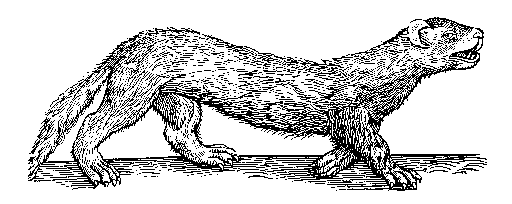

Topsel refers to his Animals as 'he' or 'she'; rarely as 'it', and at times his drawings are quite anthropomorphic - like this wonderfully cheeky Polecat. Sometimes this happens because the creatures he is working with are fantastic, and he has no model to work from, but what excuse does he have for this guy? Medieval artists drew 'funny animals', whether they meant to or not, and since drawing skills had increased dramatically by the 16th century, Topsel's book is filled with some very well-drawn near-toons.
Anyone who knows anything about Polecats will not be suprised to learn that they have 'a strong stinking savour'
The Fox is �such a devouring beast, that it forsaketh nothing fit to be eaten.� At times, a Fox will roll himself in red earth, lie on his back and hold his breath, pretending to be dead. When a bird lands upon him, he devours it. Topsel notes that he feeds �like a living and not a dead Fox.�

In Arabia, Foxes are so �ravenous, harmful and audacious, that in the night by ganning and barking, they invite one another (as it were) by a Watchword, to assemble in great multitudes together, for to prey upon all things, and they fear not to carry into their dens, old shoes and vessels, or instruments of husbandry: for which cause, when the Husbandmen hear thereof, they gather all things into their houses and watch them.�
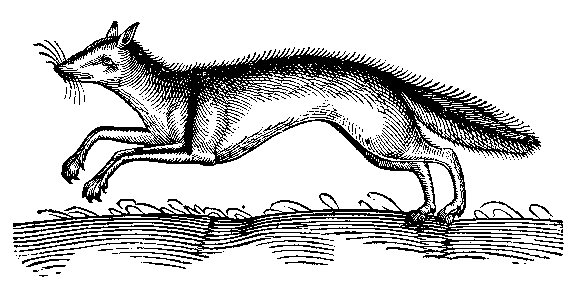
Lock up your husbandry instruments.
�Otters are most accomplished biters�, says Topsel. If he fastens onto you, he won�t let go, �until he make the bones to crack betwixt his teeth.� He is, however, somewhat greedy of fishes, to the point that he will �filleth his den so full of fishes, that he corrupteth the air; and likewise infecteth himself with a pestilent and noisome savour.� The Latins note that when an Otter is in this state �He smels like a Goat�. Topsel notes that the Germans disagree, claiming that Goats smell like Otters.

An Otter works on his aroma
The Ferret is �a bold and audacious Beast, enemy to all other, except his owne kinde, drinking and sucking in the bloude of the Beast it biteth, but eateth not the flesh.�
Topsel has suprisingly little to say about the Ferret. He expends a fair amount of energy trying to reconcile Gaza�s claim that they are �most greedy of Honey�, with Pliny�s assertion that they are filled with �a hatred and loathing thereof, in so high a degree, that if he tast of it, he falleth into Consumptions�.

A warrener�s ferret, equipped with a bell, and seeming a little unhappy
with his dinner, perhaps because there's too little blood in it.
Topsel has a great deal to say about Dogs; nearly 50,000 words actually. You might think that there wouldn't be all that much left to tell about Dogs, but you'd be wrong. For instance, 'There is a nation of people in Ethiopia (called Nube) which have a Dog in such admirable estimation, that they give unto him the honor of their King; for they have no other King but he. If he faun, they take him for well pleased; if he bark or flie upon them, they take him for angry; and by his gestures and movings they conjecture his meaning, for the government of their state'.
At other times, Topsel seems to be writing for an audience from another planet. Could there be anyone in early 17th century Britain who didn't know that 'It is the nature of a Dog when he maketh water, to hold up his leg.... the females do it for the most part sitting'?
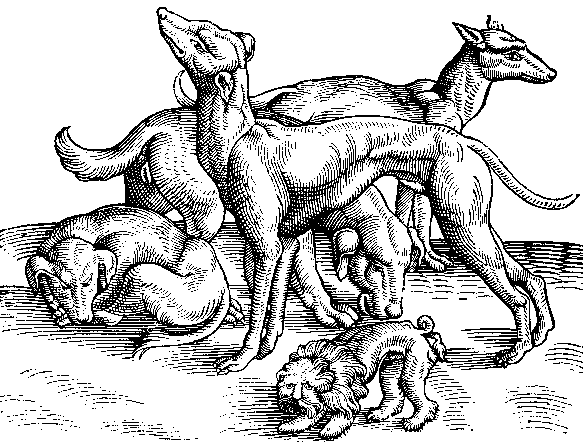
I think the little bloke at the bottom wandered in from the Fantastical section
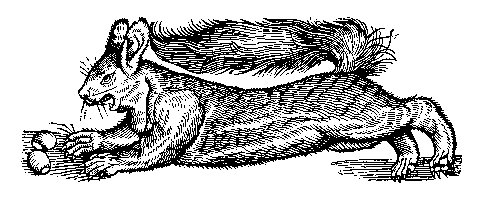
The Squirrel is here for no very good reason, except that I like the picture. Topsel notes �They are of incredible agility and motion, never standing still�. Whether this has anything to do with the fact that their �ventricle... hath been found full stuffed with excrements�, is hard to say, but personally I doubt it. Topsel has already noted that �there is no beast that is naturally so full of excrement as a Bonafus (Bison)�, and the Bonafus is not noted for its agility (Topsel does not advance this theory; it�s just me starting to think like him.)
|
The Reindeer, a beast of the Northern part of the world, towards the pole Artique�, must almost have qualified as an exotic animal to an Englishman, but I think he narrowly qualifies for the �common� section. Topsel is aware that the Reindeer is an animal crucial to the inhabitants of Scandinavia, but he does not seem to be terribly versed in Reindeer lore. He is aware, though, that �In their pace, both slow and speedy, the articles of their legs make a noise like the cracking of Nuts� (conversely, cracked nuts make a noise like Reindeer walking. I prefer that simile, actually.) |
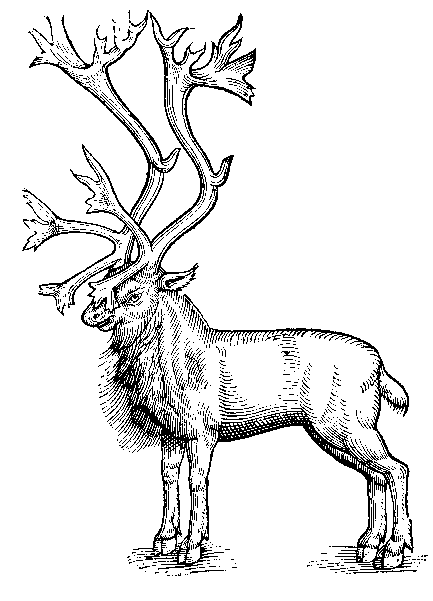
A male Reindeer, with very prodigious antlers. |
|
Reindeer milk is �the greatest part of food to those Northern people�, and the female Reindeer, as can be seen in this illustration, �want horns�. To me it looks very much like the doe in this picture is having a conversation with the Northern person who is milking her. In fact it looks a lot like the sort of pictures which used to be at the front of Punch Magazine, which the reader was supposed to supply a caption for. If anyone wants to supply a caption, please feel free to email me. |

|
I think there is a sense of wonder about animals in Topsel's writing, which I'm sure has a lot to do with why I enjoy it so much. There is, however, a definite tendency to make a value judgement about the morality of the animal. Lions are noble, and can therefore do no wrong.
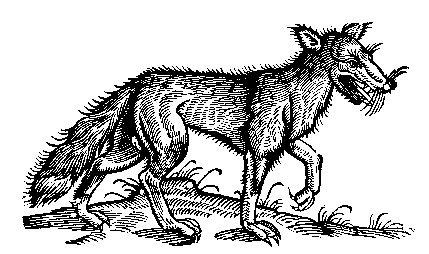
Wolves, on the other hand, are probably the mostly universally maligned beasts in medieval literature, and much of this has survived into Topsel - though in his defence, he is mostly simply quoting earlier sources. This conception of Wolves as the embodiment of evil has not entirely died down, as was brought home to me in the USA this year, where I saw a video of a rally where someone held a placard with the legend 'Wolves are the Saddam Hussein of the animal world!'
Well, before I get off on a pro-Wolf rant, here endeth the first section of my website on The History of Four-footed Beafts
Text c.1998 Tim Gadd
| Topsel main page | |
| 2. Exotic Beasts | 3. Fantastical Beasts |